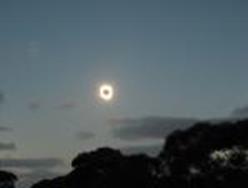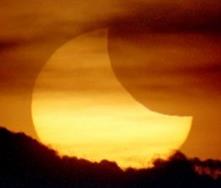![Description: Description: Description: Description: Description: Description: j0433135[1]](SCI180U01The_Universe_System_new_image003.jpg)
Course Overview
Students taking this course will explore space and plate tectonics as they continue to draw conclusions from scientific evidence that supports theories related to the change of the Earth's surface. The student will acquire knowledge to describe how the position and motions of objects in the universe cause predictable and cyclic events. Students explain that the universe is composed of vast amounts of matter and is held together by gravitational force. They explore equipment to study the universe - telescopes, probes, satellites, and spacecraft. The motion of objects, effects of forces on objects, and how waves (sound, water, and earthquake) transfer energy are explored. Students will be able to explain how the extinction of a species occurs when the environment changes and its adaptive characteristics are insufficient to allow survival. Students design a solution to a problem or design and build a product, given certain constraints. Technological influences on the quality of life are also explored in this course.
Labs - In this course, some lab activities may require normal household items for completion. Please contact your online teacher for accommodation if you do not have the items needed for a particular lab activity.
![Description: Description: Description: Description: Description: Description: j0433135[1]](SCI180U01The_Universe_System_new_image003.jpg)
THE
UNIVERSE AND OUR SOLAR SYSTEM
Unit
Overview
In this unit, students will investigate and understand the regular and predictable motion of objects in space. Students will also understand how the motion of these heavenly bodies explains such phenomena as the length of days and years, seasons, eclipses, tides, and moon cycles.
GLOSSARY
OF KEY TERMS
|
|
planet
|
any of the eight primary
bodies orbiting the sun
|
lunar tides
|
portion of a tide that is
due to the tide-producing force of the moon
|
solar system
|
the sun and all the objects
that orbit around it
|
Law of Conservation of
Matter
|
in a chemical reaction,
matter is neither created nor destroyed
|
asteroid
|
a small rocky object that
orbits the sun, usually in a band between the orbits of Mars and Jupiter
|
elliptical orbit
|
an orbit that travels in
the shape of an oval rather than a circle
|
phases
|
the different apparent
shapes of the moon or a planet due to the relative positions of the sun,
Earth, and the moon or planet
|
equinox
|
literally "equal
night"; it refers to the time of year when day and night are of equal
length
|
eclipse
|
an event that occurs when
one object passes into the shadow of another object
|
Print out the Key Term worksheet for extra practice. Key Term Worksheet
The
Solar System
Our solar system is a very
small part of the universe. The universe is all of the matter and energy that
exists, that has ever existed, and that ever will exist. That definition gives
us some clue of the immensity of the universe and that the universe never stays
the same. It is constantly changing and moving. The Law of Conservation of
Matter and Energy states that matter and energy cannot be created or destroyed,
but can change form. Scientists believe that all of the matter and energy that
existed at the beginning of time is still present and will keep changing
through cataclysmic events in space. Let’s start a study of the universe by
looking at our solar system and then moving beyond.
What makes up our solar system?
The central body in our solar system is the Sun. The Sun is a star which is a huge ball of hot gas that emits energy in the form of heat and light. Because the Sun is such a huge amount of matter, it exerts a very strong gravitational force on all the matter in our solar system. This causes all the planets and other matter, such as asteroids, to orbit around the Sun. Since the planets are caught in the gravitational pull of the Sun, they continue to travel in predictable paths.
|
The solar system's four inner planets are
much smaller than its four outer planets, and all eight are dwarfed by the
Sun they orbit. The sizes of the bodies are shown to scale, though the
distances between them are not. The numbers given are the approximate
diameters of each body at its equator.
|
The Planets
There are eight planets that
orbit our sun. Five of these planets have been known for centuries since they could
be seen with the unaided eye, or in other words, without a telescope. Planets
do not emit their own light but reflect light from the sun. They can be
distinguished from stars because they do not remain stationary in the sky and
they do not flicker light but reflect a steady light. These planets are
Mercury, Venus, Mars, Jupiter, and Saturn. Venus is the brightest light visible
from Earth other than the sun and the moon. The early models of the solar
system show the sun and these five planets orbiting the Earth. This is called a
geocentric solar system. “Geo” means Earth and “centric” means center. People
believed that the Earth was the center of our solar system. Below is a picture
of this early model.
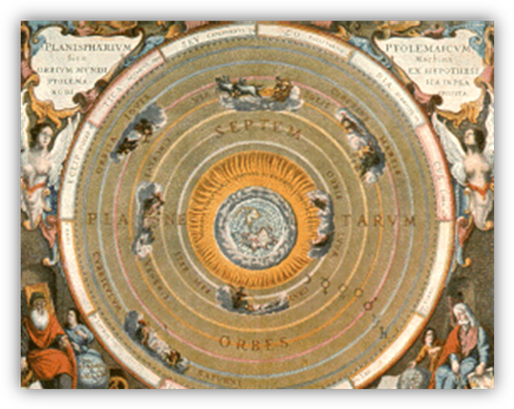
Changes in solar system models came about with the use of the telescope. The first change was the addition of three more planets: Uranus, Neptune, and Pluto. Because the telescope allowed scientists a closer look at the planets, they began to collect some interesting observations about the motion of the planets. Nicolaus Copernicus was the first to argue that all planets, including the Earth, orbit around the sun. This model of the solar system is called a heliocentric model. “Helio” means sun, and centric means center. So our solar system is a “sun-centered” system. Other scientists, such as Kepler, hypothesized that the planets moved in elliptical orbits and not in perfect circles. The picture below is a model of the modern solar system.
|
The eight planets
of the solar system and Pluto, in a montage of images scaled to show the
approximate sizes of the bodies relative to one another. Outward from the
Sun, which is represented to scale by the yellow segment at the extreme left,
are the four rocky terrestrial planets (Mercury, Venus, Earth, and Mars), the
four hydrogen-rich giant planets (Jupiter, Saturn, Uranus, and Neptune), and
icy, comparatively tiny Pluto.
|
The Outer Planets
Pluto Reclassified
When the International Astronomical Union (IAU) met on August 24, 2006, astronomers voted to reclassify Pluto as a dwarf planet. Explore the new definition of a planet and the downsizing of the solar system to eight “true” planets---changes that have sparked public debate as well as new understandings of the evolving nature of science. Learn why Pluto has been at the center of controversy since it was first recognized in 1930. As technology advanced, Pluto's position in the scientific community declined.
The
Inner Planets
·
The four inner planets are Mercury, Venus, Earth, and Mars. They are smaller than the outer planets, and they all have solid, rocky surfaces. Most of what we know about these planets comes from satellites and surface probes that scientists have sent to each planet.
·
Mercury is the closest planet to the sun. Therefore, its sun side surface temperature is over 670 K (370 degrees Celsius). The dark side surface of the planet has temperatures drop to the extreme cold of 103 K (-170 degrees Celsius). Mercury spins on its axis so slowly that it only gets in one and a half days in a year (one rotation around the sun). Mercury has almost no atmosphere, and there is no water there.
·
Venus has a very
thick atmosphere made up mostly of carbon dioxide. This thick atmosphere does
not allow the heat from the sun to radiate back into space, so the surface
temperature of Venus is very hot (over 700 K). The atmospheric pressure is also
about 90 times more than the pressure on Earth. Venus and Earth are about the
same size.
·
Earth is the
third planet from the sun and is ideal for life as we know it. It is the only
planet with large amount of liquid water, an atmosphere rich in oxygen, and
moderate temperatures that remain stable. The Earth has one natural satellite,
the moon.
·
Mars has been
studied more than any other planet. Scientists have sent several missions to
Mars, including Viking I and Viking II, which both sent probes to the surface.
Mars has a gigantic volcano named Olympus Mons, that is larger than the state
of Louisiana and three times taller than Mount Everest. Mars also has polar ice
caps that contain at least some water. The surface of Mars looks like it has
been worn or eroded by water at some time. Because of this, scientists are
hopeful that there will be some evidence of life, even on the microscopic
level, that might have existed at some time on Mars.
Our solar system also contains an asteroid belt that divides the inner and outer planets. This belt lies between Mars and Jupiter and is composed of hundreds of rocky objects called asteroids. While most of these asteroids remain in this belt, some will wander out of the plane in which the planets orbit. Some have crossed the Earth’s orbit, and small pieces of these asteroids have entered our atmosphere. These are the “shooting stars” you see on summer nights. These small rocks (asteroids) burn up as they enter the atmosphere.
How does planetary
orbiting affect days and years?
Each planet travels in an elliptical orbit around the sun. The amount of time a planet takes to make one orbit around the sun is called a year. The length of a year is not the same for every planet since it takes some planets much longer to travel their lap around the sun than others.
Each planet also rotates on its axis, or in other words, the planet spins. The amount of time a planet takes to make one full rotation on its axis is called a day. Just like years, the length of a day is different from planet to planet because they spin at different rates. Below is a chart showing the length of years and days for each planet. The length of the days and years are measured in Earth time so you can compare them. For instance, Earth’s day lasts 23.93 hours, while Mercury has a day that lasts 58.65 Earth days long!
The rotation and tilt of the Earth affect our seasons as well. In the summer months, the sun appears high in the sky, and the days are longer and warmer. In the winter, the sun appears low in the sky, and the days are shorter and much colder. The Earth is closest to the sun on January 3rd; doesn't it seem that January 3rd would be warm then? We must understand it is not the orbit that determines the seasons but the Earth’s tilt that gives us our seasons. When the North Pole is tilted toward the sun, the sun is higher in the sky, and the days are longer with greater temperature increases in the Northern Hemisphere. The opposite is true when the North Pole is tilted away from the sun. At this time, the Southern Hemisphere is closer to the sun, and summer will occur there while winter is in the Northern Hemisphere. The northern Hemisphere's shortest day of the year occurs on December 21st and is called the winter solstice. The summer solstice is the longest day of the year in the Northern Hemisphere and occurs on June 21st. There are two days when the day and night are of equal length because the Earth’s axis is tilted neither away from nor toward the sun. These are the vernal (spring) equinox, which occurs on March 21st and the autumnal (fall) equinox, which occurs on September 22nd. Here is a graphic of the Earth’s seasons:
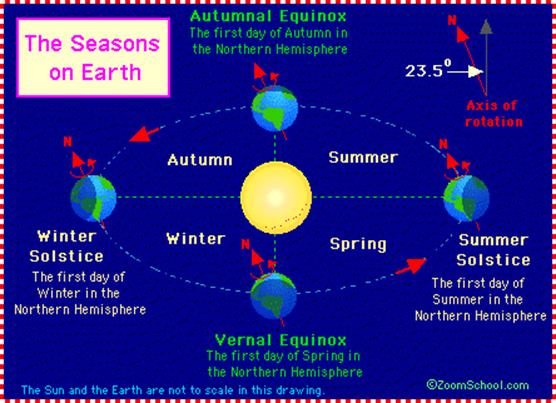
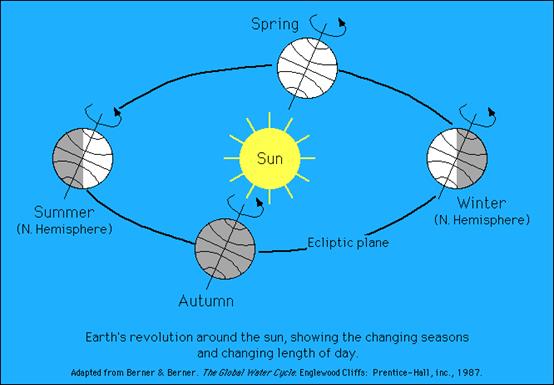
What is the
relationship between the Earth and the Moon?
Our Earth has one natural
satellite that we call the Moon. The moon reflects the sun's light in the
same way that the planets do. The moon has almost no atmosphere and is riddled
with craters from asteroid hits that happened early in the solar system’s
development.
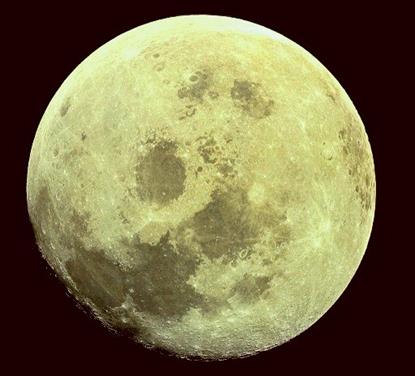
The moon does not spin, so we are always looking at the same side. However, the moon does orbit the Earth, and it sometimes appears that the moon has different shapes. These are called moon phases. Moon phases are determined by the Earth, moon, and sun positions. The sun always shines on half of the moon at one time, just like on Earth. When we see a full moon, the sun is shining on the half of the moon that is facing us. Other moon phases happen when the sun is shining on half of the moon that is not visible to us. Study the chart of moon phases below and see if you can better understand why we see smaller portions of the moon reflecting back at us than at other times.
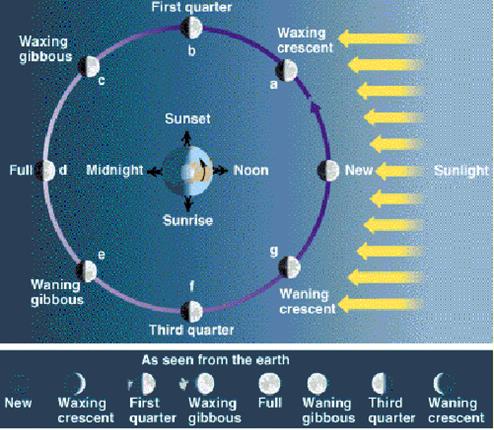
There are times when the Earth is orbiting the sun that it actually interferes with sunshine that would hit the moon. As the moon orbits the Earth, it too can interfere with the sunlight that strikes the Earth. These interferences of sunlight are called eclipses. For an eclipse to happen, the sun, moon, and Earth must be in a line. When the moon blocks out the sunlight directed from the sun to the Earth, a solar eclipse takes place. When the Earth blocks the sunlight directed from the sun to the moon, a lunar eclipse takes place. Since the moon’s orbit is slightly tilted compared to Earth, the moon is rarely in perfect alignment with the Sun and Earth, so eclipses are rare. A total eclipse of the sun is very rare.
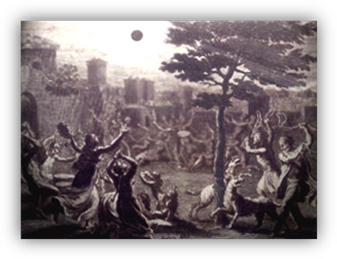
In ancient times, many people
believed a total solar eclipse was the work of evil and signaled the end of the Earth.
Over time, people realized that eclipses were predictable and a natural event
that need not be feared.
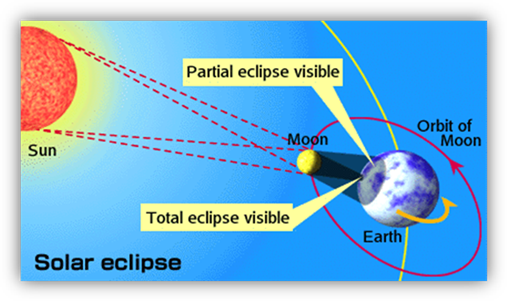
Have you ever seen
an eclipse? Here are some photos of solar eclipses.
